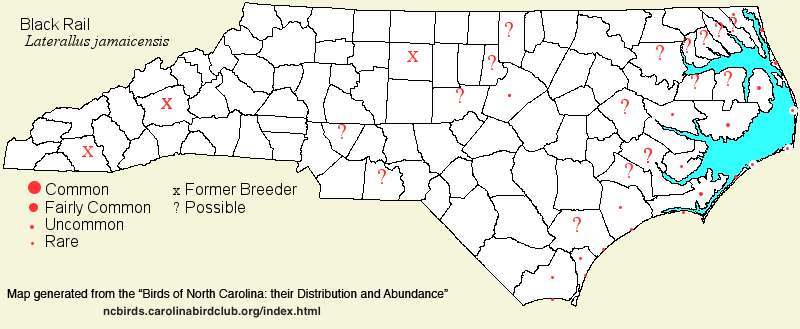 |  |
|
Black Rail - Laterallus jamaicensis RALLIDAE Members: | Search Common: Search Scientific: |
|
|
|||||||
| General Comments |
As notoriously secretive as the Yellow Rail, this species at least can be coaxed into view on occasions in North Carolina because it breeds in the state. Hearing a Black Rail call in our coastal marshes isn't overly challenging, as long as one visits the marshes at night or twilight. The birds seldom call during the day, and thus are more responsive to tapes and being observed in dark conditions. Occasionally birds can be flushed underfoot by walking, or by dragging a weighted rope, but most observations are done by watching for the birds to cross a tiny opening in response to a taped song or call. As with Yellow Rails, the overall range on the continent is imperfectly known, but the Black Rail both nests and winters along the state's coast, and possibly breeds inland (at least formerly). For breeding, birds favor extensive brackish marshes dominated by Black Needlerush (Juncus roemerianus) and/or Saltmeadow Cordgrass (Spartina patens), but they also nest in fresh marshes and wet grasslands, as long as the vegetation is waist-high or less. In winter, the species seems restricted to the brackish marshes, but the extent of the winter range is very poorly known.
Sadly, censuses of some of the coastal marshes in the past two decade have shown an alarming decline in breeding numbers in NC and VA, for no obvious reason (unless the marshes are becoming fire-suppressed or are being affected by increased salinity or higher water levels). Tropical storms that flood marshes might also be a factor, though other rail species do not seem to be affected. As a result, in 2018 it was considered by the U.S. Fish and Wildlife Service for Federal listing as Threatened. In October 2020, the Eastern subspecies (L. j. jamaicensis) -- the one on the Atlantic Coast -- was officially listed as Threatened. As a result, the N.C. Wildlife Resources Commission elevated the State Status from Special Concern to now State Threatened. | ||||||
| Breeding Status | Breeder | ||||||
| NC BRC List | Definitive | ||||||
| State Status | T | ||||||
| U.S. Status | T | ||||||
| State Rank | S1 | ||||||
| Global Rank | G3 | ||||||
| Coastal Plain | Permanent resident, with migratory movements, near the coast; strongly decreasing in recent years. Seemingly quite local, but uncommon to (formerly) locally common breeder, from Carteret northward, both along the coast and along the mainland side of Pamlico Sound and along tributary rivers. Formerly quite common at Cedar Island and Piney Island, but probably only fairly common now. Also nests in marshes along Currituck Sound. However, seemingly rare and local in coastal marshes south of Carteret. Not certain if it breeds in the Tidewater away from tidal marshes, and farther inland; basically, casual to very rare in these areas. In winter, known mainly from Roanoke Island and Carteret, but likely in winter at many sites where it breeds; two recent records for CBC's at Southport and Wilmington. One seen in Gull Rock Game Land (Hyde ) on 29 Dec 2012 was quite far "inland" at that season. The percentage of breeders that depart the state in fall and winter is not known, though it seemingly is less numerous in winter. In fact, the species has been difficult or impossible to find in winter in recent years at sites where it was formerly recorded in winter. Peak counts: 74, Cedar Island, 23 May 1974; (away from Cedar Island) 19, Piney Island, 19 Jun 1992. | ||||||
| Piedmont | Poorly known breeder (at least formerly) and transient. Casual to very rare breeder, at least formerly, in the Triangle area; known to have nested near Raleigh on many occasions between 1890 and the 1930's. Nested in Guilford in 1893, vaguely reported to have nested at Statesville prior to 1942, and possibly nested in Surry in 1959. Most recent summer season record -- south of Raleigh in May - Jun 2005. Very few records of migrants, and several refer to tower kills, when it is apparent that birds at least fly over the region at night during migration. Dates range from late Apr to mid-Jul, with additional single records for the Charlotte area, 21 Sep 1979 (tower kill) and Guilford, 25 Nov 1970. Peak counts: all single birds, except for an adult and two young at Jamestown, 1893. | ||||||
| Mountains | Formerly casual breeder at low elevations; now essentially unknown/accidental. Formerly nested near Asheville and near Franklin, in the 19th and early 20th centuries. No records in many decades. | ||||||
| Finding Tips |
To hear a Black Rail, visit the Cedar Island marsh causeway (NC 12), or the Wanchese marshes east of NC 345, or the North River marshes north of US 70. The species has recently been seen and heard from the boardwalk at the Bodie Island Lighthouse Pond. You will need to visit near sundown, and be prepared to stay until well after dark. Place a tape recorder (might not be allowed at Bodie Island) in a cleared area in a marsh, and be prepared to watch for a rail to approach the tape recorder; this should be done near dusk or at night. Have a flashlight ready for quick use. ** | ||||||
| Attribution | LeGrand[2024-10-29], LeGrand[2023-03-09], LeGrand[2023-01-23] | ||||||
| NC Map Map depicts all counties with a report (transient or resident) for the species. | Click on county for list of all known species. |
| NC Breeding Season Map Map depicts assumed breeding season abundance for the species. |  |